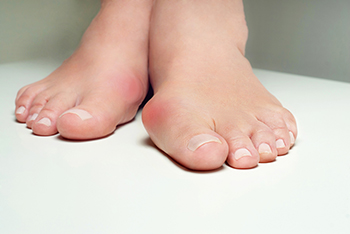Connect With Us
Blog
Wearing Tight Shoes May Cause a Bunion

A bunion can be caused for various reasons, including genetic factors, aging, and choosing shoes that do not have enough room for the toes to move freely in. Wearing tight shoes may cause a bony protrusion on the side of the big toe, which may push the other toes toward each other. The medical term for a bunion is referred to as hallux valgus, which is considered a deformity. Protruding bunions may cause pain and pressure, and medical attention is often sought for relief. Calluses and corns may form on top of the toes due to the foot touching the top or side of the shoe. Prevention methods for bunions can be implemented by wearing shoes with adequate room in the toe area, and walking barefoot can help to strengthen the overall foot. If you have developed a bunion, it is suggested that you schedule an appointment with a podiatrist who can offer you additional relief options.
If you are suffering from bunion pain, contact Dean Kim, DPM of Greater Texas Foot & Ankle Specialist. Our doctor can provide the care you need to keep you pain-free and on your feet.
What Is a Bunion?
Bunions are painful bony bumps that usually develop on the inside of the foot at the joint of the big toe. As the deformity increases over time, it may become painful to walk and wear shoes. Women are more likely to exacerbate existing bunions since they often wear tight, narrow shoes that shift their toes together. Bunion pain can be relieved by wearing wider shoes with enough room for the toes.
Causes
- Genetics – some people inherit feet that are more prone to bunion development
- Inflammatory Conditions - rheumatoid arthritis and polio may cause bunion development
Symptoms
- Redness and inflammation
- Pain and tenderness
- Callus or corns on the bump
- Restricted motion in the big toe
In order to diagnose your bunion, your podiatrist may ask about your medical history, symptoms, and general health. Your doctor might also order an x-ray to take a closer look at your feet. Nonsurgical treatment options include orthotics, padding, icing, changes in footwear, and medication. If nonsurgical treatments don’t alleviate your bunion pain, surgery may be necessary.
If you have any questions, please feel free to contact our office located in Frisco, TX . We offer the newest diagnostic and treatment technologies for all your foot care needs.

